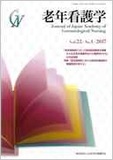Japanese
English
- 販売していません
- Abstract 文献概要
- 参考文献 Reference
抄録
本研究の目的は,高齢者の熱傷の特徴と「熱傷の重症度」への影響要因について明らかにすることである.熱傷で受診した高齢者130人の診療録・看護記録を遡及的実態調査し,前期高齢者81人と後期高齢者49人で比較分析した結果,前期高齢者では「末梢神経障害」,後期高齢者では「認知症」「眼疾患」が有意に多かった(p<0.05).高齢者の熱傷の特徴として,受傷原因は「高温液体」が両者ともに3割と最多であったが,前期高齢者に比べ後期高齢者では受傷部位が「背部」に多く,熱傷面積が13.5(1.0〜45.0)%と広範囲で,重症熱傷者が22.4%と多かった(p<0.05).「熱傷の重症度」を従属変数とした重回帰分析の結果,前期高齢者では「火炎」「胸部」「右下腿」「顔面」「発見者の存在」(決定係数R2=0.593)が,後期高齢者では「背部」と「火炎」(R2=0.649)が影響要因として挙げられた.今後は,日常生活上の注意喚起のみならず,感覚機能の低下や認知症に配慮した環境の工夫といった熱傷予防の必要性が示唆された.
We examined the characteristics and factors influencing the severity of burns. 130 patients were categorized into two groups: “younger elderly” (aged 60-74) and “older elderly” (aged 75 or more). We retrospectively investigated the medical and nursing records of the 130 elderly burn patients and categorized 81 of them as younger elderly and 49 of them as older elderly. As underlying medical conditions, ‘peripheral neuropathy' is significantly higher in the younger elderly, and ‘dementia' or ‘ocular disorder' are significantly higher in the older elderly (p < 0.05, each). The most frequent burn cause was found to be “high-temperature fluid”, accounting for three out of ten. A greater share of older elderly than younger elderly had burns on their back, and the burn area was greater in the older elderly than in the younger elderly at a median 13.5 (range: 1.0-45.0)%. In addition, a significantly greater share of older elderly [22.4% (p < 0.05)] than younger elderly had severe burns. Multi-regression analysis with Burn Index score as the dependent variable showed that “flame” “chest” “right lower leg” “face” and “perceptions of burn” had greater impacts on the younger elderly group (R2=0.593) and that “back” and “flame” had greater impacts on the older elderly group as an environmental factors (R2=0.649).
We speculate that burn injuries in the elderly could be mitigated not only by raising awareness of burns in daily life but also focusing concern on the living environment including the persons who have a loss of sensory function or dementia.
Copyright © 2017, Japan Academy of Gerontological Nursing All rights reserved.


